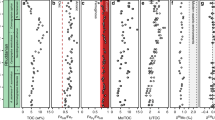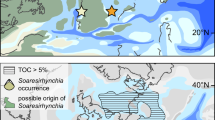Abstract
Arising from: M. Wille, T. F. Nägler, B. Lehmann, S. Schröder & J. D. Kramers Nature 453, 767–769 (2008)10.1038/nature07072; Wille et al. reply
The cause of the most marked changes in the evolution of life, which define the first-order stratigraphic boundary between the Precambrian and the Phanerozoic eon, remains enigmatic and a highly topical subject of debate. A global ocean anoxic event, triggered by large-scale hydrogen sulphide (H2S) release to surface waters, has been suggested by Wille et al.1, on the basis of two data sets from South China and Oman, to explain the fundamental biological changes across the Precambrian/Cambrian (PC/C) boundary. Here we report a new precise SHRIMP U–Pb zircon age of 532.3 ± 0.7 million years (Myr) ago (Fig. 1) for a volcanic ash bed in the critical unit that reflects the ocean anoxic event, the lowermost black shale sequence of the Niutitang Formation in the Guizhou Province, South China. This age is significantly younger than the precise PC/C boundary age of 542.0 ± 0.3 Myr ago2, approximately 10 Myr younger than the extinction of the Ediacaran fauna, and thus challenging the view of a major ocean anoxic event having been responsible for the major changes in the direction of evolution at the PC/C boundary.

The analysed spots shown in yellow circles and the zircons display a clear oscillatory magmatic zonation (see inserted cathodoluminescence images) without inherited cores and were therefore chosen for constraining the age of crystallization (that is, 532.3 ± 0.7 Myr ago; with 1 SE error and MSWD (mean square of weighted deviates) = 0.24).
This is a preview of subscription content, access via your institution
Access options
Subscribe to this journal
Receive 51 print issues and online access
$199.00 per year
only $3.90 per issue
Buy this article
- Purchase on Springer Link
- Instant access to full article PDF
Prices may be subject to local taxes which are calculated during checkout
Similar content being viewed by others
References
Wille, M., Nägler, T. F., Lehmann, B., Schröder, S. & Kramers, J. D. Hydrogen sulphide release to surface waters at the Precambrian/Cambrian boundary. Nature 453, 767–769 (2008)
Amthor, J. E. et al. Extinction of Cloudina and Namacalathus at the Precambrian-Cambrian boundary in Oman. Geology 31, 431–434 (2003)
Li, G. et al. Early Cambrian metazoan fossil record of South China: Generic diversity and radiation patterns. Palaeogeogr. Palaeoclimatol. Palaeoecol. 254, 229–249 (2007)
Zhu, M. et al. Sinian and early Cambrian stratigraphic framework for shallow- to deep-water environments of the Yangtze Platform: an integrated approach. Prog. Nat. Sci. 13, 951–960 (2003)
Steiner, M., Willis, E., Erdtmann, B. D., Zhao, Y. L. & Yang, R. D. Submarine-hydrothermal exhalative ore layers in black shales from South China and associated fossils—insights into a Lower Cambrian facies and bio-evolution. Palaeogeogr. Palaeoclimatol. Palaeoecol. 169, 165–191 (2001)
Jiang, S. Y. et al. Trace- and rare-earth element geochemistry and Pb-Pb dating of black shales and intercalated Ni-Mo-PGE-Au sulfide ores in Lower Cambrian strata, Yangtze Platform, South China. Mineralium Deposita 41, 453–467 (2006)
Jiang, S. Y. et al. Extreme enrichment of polymetallic Ni-Mo-PGE-Au in Lower Cambrian black shales of South China: an Os isotope and PGE geochemical investigation. Palaeogeogr. Palaeoclimatol. Palaeoecol. 254, 217–228 (2007)
Author information
Authors and Affiliations
PowerPoint slides
Rights and permissions
About this article
Cite this article
Jiang, SY., Pi, DH., Heubeck, C. et al. Early Cambrian ocean anoxia in South China. Nature 459, E5–E6 (2009). https://doi.org/10.1038/nature08048
Received:
Accepted:
Issue Date:
DOI: https://doi.org/10.1038/nature08048
This article is cited by
-
Inverse Mo versus U isotope correlation of Early Cambrian highly metalliferous black shales in South China indicates synsedimentary metal enrichment from a near-modern ocean
Mineralium Deposita (2024)
-
A Diverse Microfossil Assemblage from the Ediacaran–Cambrian Deep-Water Chert of the Liuchapo Formation in Guizhou Province, South China
Journal of Earth Science (2023)
-
Geochemical Characterization of Organic Rich Black Rocks of the Niutitang Formation to Reconstruct the Paleoenvironmental Settings during Early Cambrian Period from Xiangxi Area, Western Hunan, China
Journal of Earth Science (2023)
-
Re-Os Geochronology of the Liuchapo Formation across the Ediacaran-Cambrian Boundary of the Yangtze Block (South China)
Journal of Earth Science (2022)
-
Provenance of Lower Carboniferous Bauxite Deposits in Northern Guizhou, China: Constraints from Geochemistry and Detrital Zircon U-Pb Ages
Journal of Earth Science (2021)
Comments
By submitting a comment you agree to abide by our Terms and Community Guidelines. If you find something abusive or that does not comply with our terms or guidelines please flag it as inappropriate.



